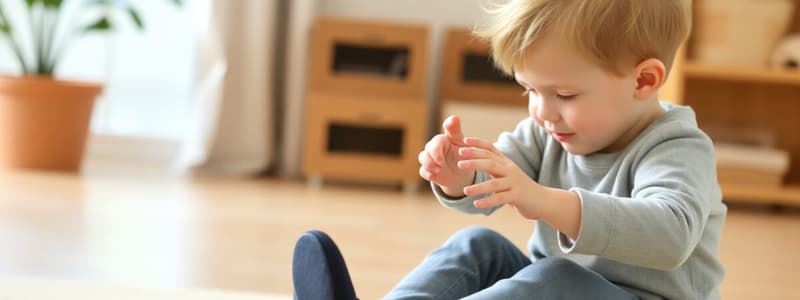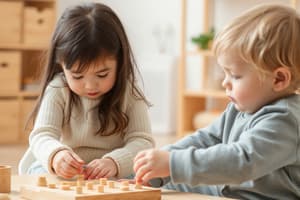Podcast
Questions and Answers
What is the first stage of motor skill development in children?
What is the first stage of motor skill development in children?
- Core muscle control (correct)
- Gross motor skills development
- Fine motor skills refinement
- Control of hand muscles
Which of the following best describes gross motor skills?
Which of the following best describes gross motor skills?
- Precise movements using fingers
- Movements requiring balance on one foot
- Larger movements involving arms and legs (correct)
- Simple hand movements like waving
What is an important milestone for hand stability during the first year of life?
What is an important milestone for hand stability during the first year of life?
- Catching a ball with both hands
- Walking without support
- Holding small objects purposefully (correct)
- Grasping a toy with two hands
Which component of the body is crucial for maintaining posture and balance?
Which component of the body is crucial for maintaining posture and balance?
At what age do children typically develop the ability to catch an 8-inch ball?
At what age do children typically develop the ability to catch an 8-inch ball?
What type of activities can early childhood educators use to promote core stability?
What type of activities can early childhood educators use to promote core stability?
Which statement best reflects the importance of stability in motor skill development?
Which statement best reflects the importance of stability in motor skill development?
How does core strength support motor development?
How does core strength support motor development?
What does fine motor skills development involve?
What does fine motor skills development involve?
What type of play helps strengthen core muscles in children?
What type of play helps strengthen core muscles in children?
What does hand stability allow children to do during development?
What does hand stability allow children to do during development?
Why is promoting good posture essential in childhood?
Why is promoting good posture essential in childhood?
At what age do children typically start to go up and down stairs without support?
At what age do children typically start to go up and down stairs without support?
Match the following types of motor skills with their descriptions:
Match the following types of motor skills with their descriptions:
Match the following age-related developmental milestones with their corresponding abilities:
Match the following age-related developmental milestones with their corresponding abilities:
Match the following terms with their definitions related to motor skills:
Match the following terms with their definitions related to motor skills:
Flashcards
Proximal to Distal Development
Proximal to Distal Development
The development of motor skills from the center of the body outward, starting with core muscles and progressing to arms and legs, then hands and feet.
Core Muscles
Core Muscles
The group of muscles in the midsection, including the abdomen, lower back, hips, and pelvis, essential for balance, posture, and movement.
Gross Motor Skills
Gross Motor Skills
Skills involving larger muscle movements, like reaching, crawling, standing, and walking.
Fine Motor Skills
Fine Motor Skills
Signup and view all the flashcards
Stability
Stability
Signup and view all the flashcards
Hand Stability
Hand Stability
Signup and view all the flashcards
Shoulder Stability
Shoulder Stability
Signup and view all the flashcards
Body Stability
Body Stability
Signup and view all the flashcards
Active Play
Active Play
Signup and view all the flashcards
Structured Exercises
Structured Exercises
Signup and view all the flashcards
Promoting Good Posture
Promoting Good Posture
Signup and view all the flashcards
Diverse Movement Experiences
Diverse Movement Experiences
Signup and view all the flashcards
Core Strengthening Activities
Core Strengthening Activities
Signup and view all the flashcards
Safe Environment
Safe Environment
Signup and view all the flashcards
Supporting Body Stability Development
Supporting Body Stability Development
Signup and view all the flashcards
What are core muscles?
What are core muscles?
Signup and view all the flashcards
What are gross motor skills?
What are gross motor skills?
Signup and view all the flashcards
What are fine motor skills?
What are fine motor skills?
Signup and view all the flashcards
What is stability?
What is stability?
Signup and view all the flashcards
What is hand stability?
What is hand stability?
Signup and view all the flashcards
What is shoulder stability?
What is shoulder stability?
Signup and view all the flashcards
What is body stability?
What is body stability?
Signup and view all the flashcards
What is active play?
What is active play?
Signup and view all the flashcards
What are structured exercises?
What are structured exercises?
Signup and view all the flashcards
What is promoting good posture?
What is promoting good posture?
Signup and view all the flashcards
What are diverse movement experiences?
What are diverse movement experiences?
Signup and view all the flashcards
What are core strengthening activities?
What are core strengthening activities?
Signup and view all the flashcards
What is a safe environment?
What is a safe environment?
Signup and view all the flashcards
How do you support body stability development?
How do you support body stability development?
Signup and view all the flashcards
Study Notes
Motor Skill Development
- Motor skills develop from the body's center (proximal) outward (distal).
- Initially, babies focus on core muscles (neck, shoulders, trunk) for balance and posture (e.g., sitting, crawling). This core strength is essential for milestones like sitting, crawling, and walking.
- Gross motor skills (larger movements) develop next, involving arms and legs (e.g., reaching, crawling, walking). These skills enable exploration, muscle strength building, and coordination.
- Fine motor skills (smaller movements) involve hands and feet, enabling precision (e.g., grasping, writing, using utensils). These precise movements require dexterity and good hand-eye coordination.
- This progression is crucial for everyday activities, academic tasks, and overall physical development.
Stability Development
- Stability is a combination of strength and balance, allowing one body part to stay still while another moves. Three types of stability are crucial: hand, shoulder, and body stability.
- Hand stability develops by holding objects, even with the arm moving.
- Body stability begins with holding the head up and continues to sitting up, or sitting while moving arms or hands to grasp.
- Shoulder and hand stability milestones include reaching, sitting for longer durations (over 5 minutes), standing with support, holding toys when crawling, and carrying toys (eventually multiple toys).
- Between 1-2 years old, children develop the ability to carry multiple toys, pull toys, and go up/down stairs.
- Children can catch a ball, use scissors/tongs with one hand, and grasp a marker with thumb and fingers.
- Ongoing improvement in body, shoulder, arm, and hand stability occurs throughout childhood. Milestones include eventually catching a ball (8-inch), and using tools like scissors and tongs with one hand, and grasping a marker with thumb and fingers.
Core Stability
- The core consists of muscles in the midsection (abdomen, lower back, hips, pelvis).
- Core muscles stabilize the spine for balance and movement, essential for posture, lifting, and everyday activities/exercises.
- Core stability is a foundation for fine motor skills and all further motor development.
Supporting Stability Development
- Educators can support core stability development through:
- Encouraging physical activity (running, jumping, climbing, balancing).
- Structured exercises (yoga, stretching).
- Promoting good posture (correct sitting positions, ergonomic furniture).
- Diverse movement experiences (obstacle courses, dance).
- Activities to strengthen core muscles (tummy time, balance beams, stability balls).
- Safe environment and safety guidelines.
Studying That Suits You
Use AI to generate personalized quizzes and flashcards to suit your learning preferences.




